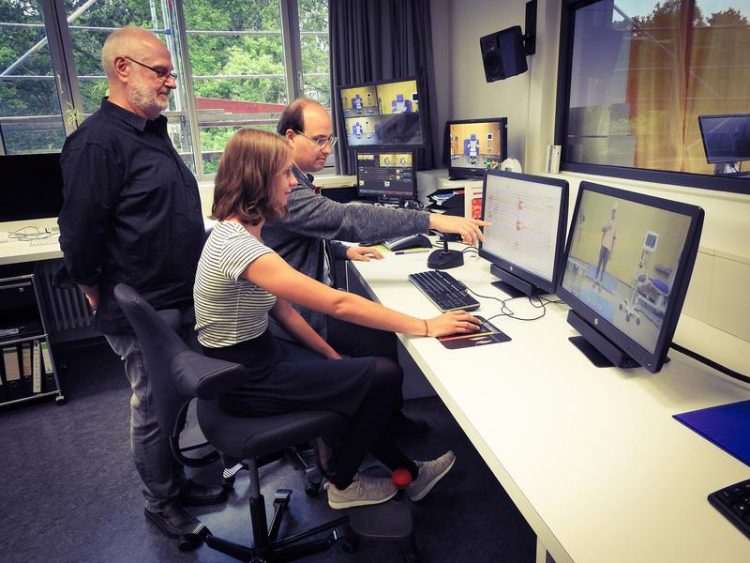Epilepsy: Seizures not forecastable as expected

Prof. Klaus Lehnertz (left) with Theresa Wilkat and Thorsten Rings in the laboratory. © Photo: Gregor Gast/UKB
During an epileptic seizure, large nerve cell clusters in the brain discharge simultaneously. The consequences are dramatic muscle spasms and loss of consciousness, which can be life-threatening.
Many researchers assume that the brain has crossed a so-called “tipping point”, which almost inevitably leads to a seizure.
The lead-up to this tipping point is supposedly heralded by characteristic changes in brain waves – so says a common hypothesis. According to this theory, nerve cell networks reproduce their own activity when close to this point:
The brain waves they produce are very similar to previous ones. At the same time, they react to disturbances with much stronger discharges than normal. Additionally, it takes longer for their activity to normalize.
“We call this 'critical slowing down', CSL for short,” explains Prof. Dr. Klaus Lehnertz from the Department of Epileptology at the University Hospital Bonn.
Together with his former colleague Theresa Wilkat and his doctoral student Thorsten Rings, the physicist searched for such CSL events. For this purpose, the researchers analyzed brain wave recordings of 28 subjects with epilepsies that could not be treated with medication.
Measurements were taken using electrodes implanted at various sites in the subjects' brains. “This is for diagnostic purposes, for example, to identify the site from which the seizures originate,” explains Lehnertz.
Unsuitable as an early warning system
The subjects had up to 70 sensors each in their brains. The scientists analyzed each individual EEG curve recorded by the sensors using sophisticated statistical methods. “We not only considered the hours before an attack, but also looked at a period of up to two weeks,” Wilkat explains.
The result was disappointing: “Although we found a number of CSL events, these usually occurred completely independent of a seizure,” emphasizes Lehnertz. “Only in two subjects we were able to observe a weak relationship with subsequent seizures.” His conclusion: “Critical slowing down” is not suitable as an early warning sign, even if this is claimed in literature again and again.
He considers it more promising not to look at individual sites in the brain, but to understand these as parts of a network that influence each other. The cause of a seizure is most likely not the activity of a single nerve cell cluster that gets out of control.
“Instead, there are feedback and amplification effects that, as a whole, lead to this massive temporary brain malfunction,” he emphasizes. Understanding these processes will also allow better forecasting techniques to be developed.
Epileptic seizures usually strike like a bolt from the blue, which significantly impacts the daily lives of those affected. For example, sufferers are not allowed to drive a car or carry out certain activities with a high risk of injury.
Epileptologists, physicists and mathematicians have therefore been trying to predict the dangerous malfunctions of the brain for more than three decades – so far with mixed success: There certainly are systems that can detect seizure precursors (using indicators other than “critical slowing down”), but at present they work only for about half of the subjects and are not particularly reliable. They can not recognize every precursor of a seizure and are also prone to false alarms.
However, this is not the only reason why scientists around the globe are looking for more reliable indicators in order to be able to warn subjects in good time. They also hope to be able to prevent an attack in advance through appropriate interventions.
Prof. Dr. Klaus Lehnertz
Department of Epileptology
University Hospital Bonn
Tel. +49 (0228) 287-15864
E-mail: Klaus.Lehnertz@ukbonn.de
Theresa Wilkat, Thorsten Rings and Klaus Lehnertz: No evidence for critical slowing down prior to human epileptic seizures; Chaos: An Interdisciplinary Journal of Nonlinear Science, DOI: 10.1063/1.5122759
Media Contact
More Information:
http://www.uni-bonn.de/All latest news from the category: Interdisciplinary Research
News and developments from the field of interdisciplinary research.
Among other topics, you can find stimulating reports and articles related to microsystems, emotions research, futures research and stratospheric research.
Newest articles

Properties of new materials for microchips
… can now be measured well. Reseachers of Delft University of Technology demonstrated measuring performance properties of ultrathin silicon membranes. Making ever smaller and more powerful chips requires new ultrathin…

Floating solar’s potential
… to support sustainable development by addressing climate, water, and energy goals holistically. A new study published this week in Nature Energy raises the potential for floating solar photovoltaics (FPV)…

Skyrmions move at record speeds
… a step towards the computing of the future. An international research team led by scientists from the CNRS1 has discovered that the magnetic nanobubbles2 known as skyrmions can be…





















